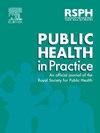Allostatic load score and lifestyle factors in the SWAN cohort: A longitudinal analysis
IF 1.9
Q2 PUBLIC, ENVIRONMENTAL & OCCUPATIONAL HEALTH
引用次数: 0
Abstract
Objectives
Allostatic load (AL) has been used to assess chronic stress. Previous studies have assessed associations between lifestyle factors and the AL. However, those studies have yet to evaluate associations longitudinally. Thus, the effect of lifestyle factors on the AL changes over time remains to be determined.
Study design
A longitudinal analysis was designed.
Methods
Our study included 1976 women identified from the Study of Women's Health Across the Nation (SWAN) who had completed at least seven waves of measurements since baseline. The Poisson mixed effects model was used to model AL and to assess how lifestyle factors affected AL over time.
Results
At baseline, the mean AL score was 2.44 (range 0–11). On average, the AL score increased by 3 % (ORs = 1.03, 95 % CI [1.01, 1.05]) per wave over time. For lifestyle factors, women who smoked cigarettes over time had higher AL than those who never smoked. On the other hand, women who ever drank alcohol at baseline, had leisure physical activity over time, and had at least average sleep quality at baseline, and had lower AL than their counterparts. We also identified a statistically significant interaction between alcohol drinking and time (P < 0.01). Furthermore, we generated a healthy score using the four lifestyle factors above to assess the potential accumulative effect of lifestyle factors on AL. We found that the AL increased by 16 % for each additional unhealthy lifestyle factor (ORs = 1.16, 95%CI: 1.12, 1.2).
Conclusions
This study demonstrates that lifestyle factors can influence the increase of AL over time.
SWAN队列中的适应负荷评分和生活方式因素:一项纵向分析
目的用适应负荷(allostatic load, AL)来评估慢性应激。先前的研究已经评估了生活方式因素与AL之间的关系。然而,这些研究尚未对其进行纵向评估。因此,生活方式因素对AL随时间变化的影响仍有待确定。研究设计采用纵向分析。方法本研究纳入了1976名从全国妇女健康研究(SWAN)中确定的女性,这些女性从基线开始至少完成了七次测量。泊松混合效应模型用于模拟AL,并评估生活方式因素如何随时间影响AL。结果基线时,平均AL评分为2.44(范围0-11)。随着时间的推移,AL评分平均每波增加3% (or = 1.03, 95% CI[1.01, 1.05])。就生活方式因素而言,长期吸烟的女性的AL高于从不吸烟的女性。另一方面,在基线时曾经饮酒的女性,随着时间的推移进行休闲体育活动,并且在基线时至少具有平均睡眠质量,并且AL低于同行。我们还发现,饮酒与时间之间存在统计学上显著的相互作用(P <;0.01)。此外,我们使用上述四种生活方式因素生成了一个健康评分,以评估生活方式因素对AL的潜在累积影响。我们发现,每增加一个不健康的生活方式因素,AL增加16% (or = 1.16, 95%CI: 1.12, 1.2)。结论:随着时间的推移,生活方式因素会影响AL的升高。
本文章由计算机程序翻译,如有差异,请以英文原文为准。
求助全文
约1分钟内获得全文
求助全文

 求助内容:
求助内容: 应助结果提醒方式:
应助结果提醒方式:


